c h r o n o l o g i c a l
g u i d e
> Year 1 Year 2 <
> Year 3 Year 4 <
> Year 5 Year 6 <
> Year 7 Year 8 <
> Year 9 Year 12 <
fetching & dismantling
sandblasting & evil rust
right "b" pillar
fixing right inner sill
basic body repair, por-15
frame removed, footwell repair
hole fixed, car flipped, etc.
sill stiffeners, rear bulkhead, etc.
various small parts
left sill, added stiffener, etc.
- lousy weather
trunk floor (reprise)
right floor, left sill, etc.
left floor, wheel well, etc.
right upper wishbone
floor done, car righted
rack, front frame, evil rust
left door cleaned & fitted
right door, right suspension
bonnet, part 1
bonnet, part 2
bonnet, part 3
bonnet, part 4
bonnet, part 5, etc.
bonnet, part 6
bonnet, outer sill, etc.
lots of stuff
left side, bonnet internals
frame, bonnet attached
engine stand, oil pan removal
pistons removed, sanding
sanding, final filling
color, frames, primer
brushed primer test
2nd coat primer
holiday greetings!
finish prep, detail on dent fix
spraying primer
winter chores
1. undercoat, plating prep
2. plating, spraying color
bonnet, plate prep, cylinder head
cylinder head paint, bushes
plating saga
front frame, suspension, part 1
front suspension, part 2
front suspension, part 3
priming and painting
bonnet, part 7
painting color!
boot lid, steering wheel
gas tank
winter chores
1. firewall sundry
2. front suspension
3. steering setup
4. master cylinders/pedals
5. the rest
data plate screed
winter to spring
1. irs rebuild
2. trunk floor, harness
3. data plate (again)
data plate, door, headlights
dash vinyl, crosshatch aluminum
windshield, right door
interior, "widget"
chrome parts!
door handle details
rolling chassis
molasses rust removal
electrical, part 1
bores, thrust washers
new engine!
head differences
block differences
compression ratio
engine in place!
alternator
catchup & photos
it runs!
setback and brakes
darned close & engine diffs
driven
top and seats
driving and little stuff
|
|
|
What we've done since February (!) 2008
This one is for Dan.
Just under a year ago, I said I was looking for a double-groove crankshaft pulley. I published a humorous email exchange at the time, and I had resolved to
get a new pulley from Classic Jaguar. Funny how time flies — I had no idea it's been a year since that time until I fished around on my website for that link. People ask me how
the car is coming, and I think how leisurely the pace has been, punctuated by flurries of great activity. I have taken Mike Moore's advice, given a few years ago on the Jag-Lover's
forum, to do something every day, even if it only amounts to cleaning tools. Sometimes, I'll have to admit, I have been content to gaze upon the car — as if looking constituted work.
At any rate, I did get my pulley from Classic Jaguar, but I got a used part — my preference actually. And Dan Mooney was gracious, since I didn't need the accessory pulley and bolts
that he offered on his used parts listings. Dan has always been gracious and supportive through the course of
this restoration, and I have used the Classic Jaguar website
(http://www.classicjaguar.com/) a lot over the years to watch the pros at work. I like to think I've been able to take cues, at least,
from what happens in the CJ workshops, but I don't think my toolsets quite match. Neither does my talent, alas.
I went ahead a few weeks later to pick up a used low brake fluid level switch from CJ's used parts collection. One of the two that came with the car broken too badly to repair; the other
seems workable until I get around to replacing it or can figure out how to mend it. That is a challenge since the things were put together in a way that defies taking apart, and I ended up breaking both
of them utterly when I was struggling to get the aluminum canister off. See the used replacement's innards in the picture below.
Aaron has been involved with this restoration over all of the years, and he leaves to NASCAR Technical Institute
in Mooresville, North Carolina, at the end of August. He told me that he
wanted to get the engine running before he left, but it looks as though that's probably not going to happen. We have gotten the major pieces in place, and in fact we have turned the engine over
for a period to see the oil pressure pop up. (It went to 60 pounds in very little time, I'm happy to report.) Getting the ignition system straight has been a little bit of a challenge,
mainly because I didn't take the time to actually look at the distributor insides. I was expecting to hook the thing up like the original 3.8 liter engine, but the new engine has an
electronic ignition, so the setup is significantly different at least at the distributor. (See the pictures below for comparisons of the original distributor and the newer one.)
The fuel pump is in place, but I haven't connected the run of wire from the "rear" harness to the cockpit harness yet. (Remember, I modularized the wiring harnesses
a bit more than they already were.) The fuel tank filler hose is in place, too. I had to buy one of those little pieces of
rubber from a Jaguar vendor, because I couldn't find a hose with the right inner dimension. Not even McMaster-Carr had something suitable. But I did some searching after I got the hose and could
use the printed numbers on the rubber. Goodyear offers "Fuel Fill Hose SAE 30R6" in various inner dimensions.
I believe an inner dimension of 2 1/4 inches would do the trick.
Various pictures collected over the months
Inside the fuel level sensor
Essentially, it's a rheostat. (Er, maybe a potentiometer, but I think not. The thing has two, not three, leads.) The whole thing is quite delicate,
so if you go the route of cleaning it, be very careful. The brass float that dangles into the fuel drives
the blade. There are two "switches" so to speak — one that signals the variable level (the rheostat)
and the other that is on-off that signals low fuel. The lid that's removed in this photograph plays a role in completing
the circuits, too.
When I opened this little box up, it was quite encrusted. Cleaned up pretty well, though.
|
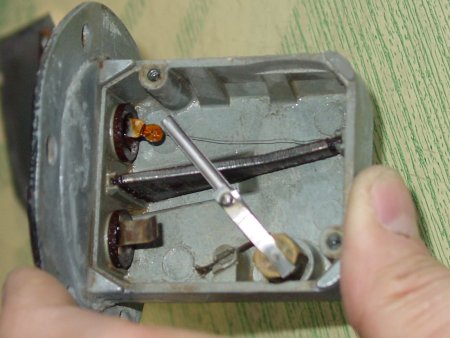
|
Looking down the XJ6 exhaust manifolds
I used the XJ6 manifolds that came with the engine I got from David Boger. Rather than heading straight down, the lower pipe
slants backwards just slightly, and the manifold include a bolt-like bung hole plug. That plug makes it much too tight a
fit against the left subframe, so I cut off the plug. The picture shows the front exhaust with plug and the rear exhaust
with the plug cut off.
I like the XJ6 manifolds for another reason: they include a heat shield setup that would seem to reflect heat downward.
With all of the work on the paint, I really don't want to have heat damage around the left louvres as I've heard some
people have seen.
Of course, the change in design means that the exhaust will have to be specially crafted, at least from the base of the manifolds
to the front of the muffler section. I don't think that will be too much of a challenge, though.
|

|
The engine compartment
Yes, please don't pay attention to the mess. One of the thing I could do (but, apparently don't) is take time to clean up the
garage. It is shared, for the time being, with son Aaron, who also leaves his junk around. Working on my car includes quite frequently asking
Aaron where tools are.
But, aside from that, the engine compartment is coming together nicely, creating a sight that offsets some of the garbage in the background.
Notably absent are the brake and clutch hydraulic fluid reservoirs and much else on that side of the engine. Since the time this photograph
was taken (early July 2008), there has been some additional progress. A battery has been fitted, the heater fan assembly has been more
firmly put in place, and a new starter solenoid (which still hasn't worked right) is set up.
You can see the oil cooler setup quite plainly, of course.
The rusty brake rotors need calipers fitted — and to be used — to get them clear of the red iron oxide. That, too, will come.
|
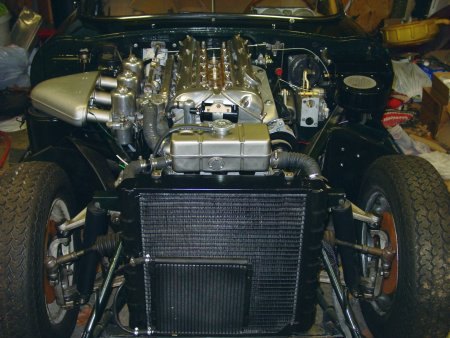
|
Lucas 22D distributor with condensor and points
This is the inside of the distributor that came with the 3.8 liter engine. It's a Lucas 22D (note the marks) and it's what I'm
familiar with — mechanical and old fashioned with points and a condensor. I suppose I could use this one, as Glen Jarboe has
on his 4.2 after he went through his engine rebuild.
I'll put this one aside, though, in favor of the distributor that came with the 4.2 replacement engine (below). If that one needs replacement,
I might go with a Pertronix.
|
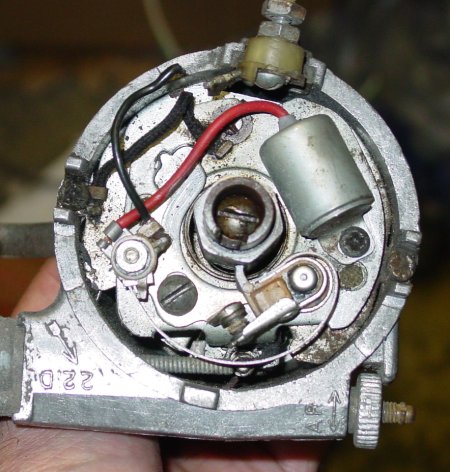
|
Lucas AB14 distributor with sensor
This distributor came with the engine I got from David Boger.
People on the Jag-Lovers XJ6 forum seemed to think that this distributor is the Lucas AB14. It's got a "CEI" (Something Electronic Ignition, probably)
that has a sensor instead of the more mechanical approach that I'm familiar with. Peter Crespin, who knows a lot more than I do
about these things, explained that the star-shaped center portion is a "normal six-point
reluctor for the
Hall effect pick-up coil
at the side of the base plate." This setup requires an amplifier, and David will be sending one to me. If the old electronic parts
don't pan out, I could install the mechanical 22D or put in a new Pertronix.
My thanks go to Frank Anderson, Al McLean, Peter Crespin, David Boger and the Jag Lovers' XJ6 forum.
|
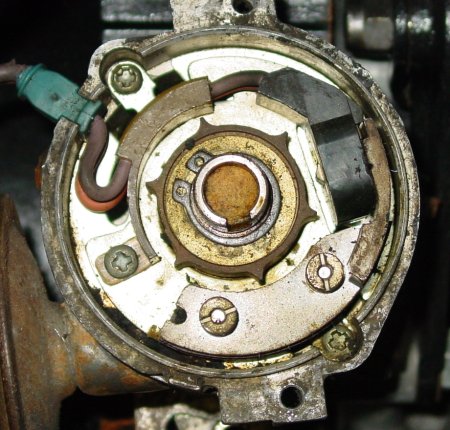
|
A handy mechanical oil pressure gauge under the bonnet
I'm not terribly impressed with the track record of the electronic oil pressure gauge. People seem to think that they're maybe accurate to within 25% (and I believe
that might be half in jest). With the two oil pressure sensor possibilities on the 4.2 liter engine I got, I went ahead and installed a mechanical gauge next to the
windshield washer bottle and above the fuel filter bowl. The copper tubing goes to where the on/off pressure sensor used to be. I believe that the XJ6 had an oil
pressure sensor there that was attached to an engine cutoff. The electronic sensor for the gauge was broken on this engine, and so I might attach the sensor from the
3.8 liter engine. It's old, but it might work.
Then, again, I might just stick a non-standard mechanical gauge in the cockpit. Lucas ones are available, I believe, though they display a different range of oil pressure
than the electronic gauges do.
Having an oil pressure gauge in the engine area is really nice. I'm considering installing a tachometer nearby, too. I believe they come in the two-inch
form factor.
|
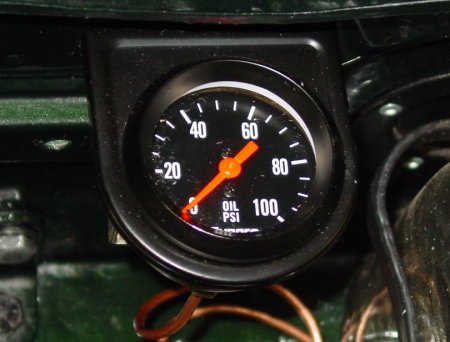
|
Insides of the brake fluid level switch
Both of my brake fluid level switches ended up being less than desirable. Both of them cracked when I tried to remove the aluminum canister that protects the
cork float. One of them is more-or-less intact and still sits atop a fluid bottle, waiting until I replace it. The other broke into small pieces, and so I
replaced it with a used part from Classic Jaguar. The replacement was really nice, and when I removed the aluminum canister, the top part came off. I took
advantage of the inadvertent disassembly to clean and photograph it.
The thing is dead simple. Simple enough that you'd think replacements would be cheaper. I just wish there was a way to replace the top cover and the canister
without having to replace the whole part. The inset photo shows where the two contacts are hit by the metal disk that's attached to the rod and float.
One thing that might help others trying to replace a besotted cork: There is a hole near the top of the canister that is slightly pressed into the plastic of the
assembly. If you take a knife and remove part of the aluminum that's pressed into the hole, you might find removing the canister easier. It worked for me.
|
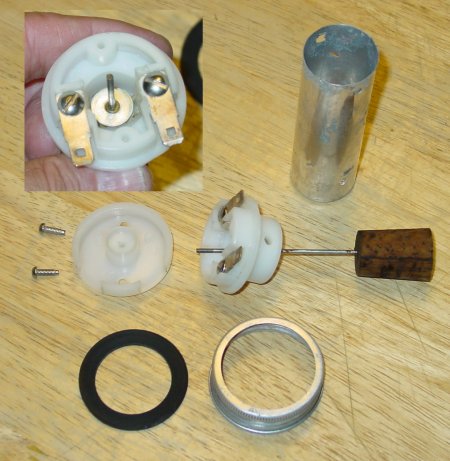
|
|
|
|

